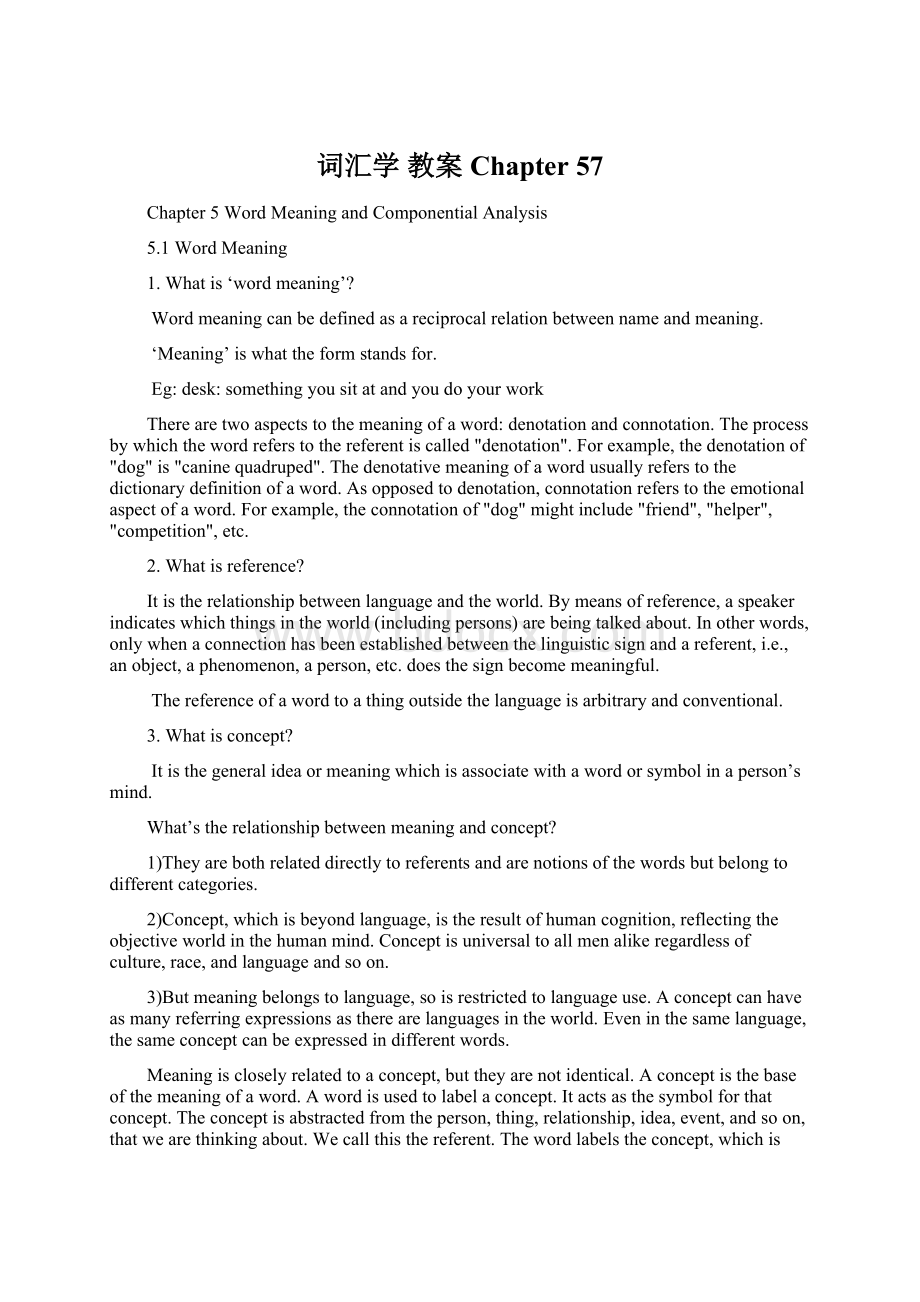词汇学 教案 Chapter 57.docx
《词汇学 教案 Chapter 57.docx》由会员分享,可在线阅读,更多相关《词汇学 教案 Chapter 57.docx(12页珍藏版)》请在冰豆网上搜索。

词汇学教案Chapter57
Chapter5WordMeaningandComponentialAnalysis
5.1WordMeaning
1.Whatis‘wordmeaning’?
Wordmeaningcanbedefinedasareciprocalrelationbetweennameandmeaning.
‘Meaning’iswhattheformstandsfor.
Eg:
desk:
somethingyousitatandyoudoyourwork
Therearetwoaspectstothemeaningofaword:
denotationandconnotation.Theprocessbywhichthewordreferstothereferentiscalled"denotation".Forexample,thedenotationof"dog"is"caninequadruped".Thedenotativemeaningofawordusuallyreferstothedictionarydefinitionofaword.Asopposedtodenotation,connotationreferstotheemotionalaspectofaword.Forexample,theconnotationof"dog"mightinclude"friend","helper","competition",etc.
2.Whatisreference?
Itistherelationshipbetweenlanguageandtheworld.Bymeansofreference,aspeakerindicateswhichthingsintheworld(includingpersons)arebeingtalkedabout.Inotherwords,onlywhenaconnectionhasbeenestablishedbetweenthelinguisticsignandareferent,i.e.,anobject,aphenomenon,aperson,etc.doesthesignbecomemeaningful.
Thereferenceofawordtoathingoutsidethelanguageisarbitraryandconventional.
3.Whatisconcept?
Itisthegeneralideaormeaningwhichisassociatewithawordorsymbolinaperson’smind.
What’stherelationshipbetweenmeaningandconcept?
1)Theyarebothrelateddirectlytoreferentsandarenotionsofthewordsbutbelongtodifferentcategories.
2)Concept,whichisbeyondlanguage,istheresultofhumancognition,reflectingtheobjectiveworldinthehumanmind.Conceptisuniversaltoallmenalikeregardlessofculture,race,andlanguageandsoon.
3)Butmeaningbelongstolanguage,soisrestrictedtolanguageuse.Aconceptcanhaveasmanyreferringexpressionsastherearelanguagesintheworld.Eveninthesamelanguage,thesameconceptcanbeexpressedindifferentwords.
Meaningiscloselyrelatedtoaconcept,buttheyarenotidentical.Aconceptisthebaseofthemeaningofaword.Awordisusedtolabelaconcept.Itactsasthesymbolforthatconcept.Theconceptisabstractedfromtheperson,thing,relationship,idea,event,andsoon,thatwearethinkingabout.Wecallthisthereferent.Thewordlabelstheconcept,whichisabstractedfromthereferent;theworddenotesthereferent,butdoesnotlabelit.Thisapproachtomeaningcanbediagrammedasfollows:
word-concept–referent
Theformulashowsthatthewordreferstothereferentthroughaconcept.
Aconceptisanabstractionfromthingsofthesamekind.
4.Whatissense?
Thesenseofanexpressionisitsplaceinasystemofsemanticrelationshipswithotherexpressionsinthelanguage.
What’sthedifferencebetweenreferenceandsense?
1)Sensedenotestherelationshipsinsidethelanguage.
2)Everywordthathasmeaninghassensebutnoteverywordhasreference.
5.2Motivation
1.Whatismotivation?
Motivationdealswiththeconnectionbetweennameandsense
2.Typesofmotivation
A.OnomatopoeicMotivation
Itmeanstheimitationofsoundsbysounds.OnomatopoeiaisderivedfromGreekonomatopoeia"word-making":
onoma,-matos"name"+poieo"make".Variousothertermshavebeensuggested,suchasechoism(Jespersen)and"phonaestheticfunction"(Firth).Onomatopoeicmotivationmeansdefiningtheprincipleofmotivationbysound.Thesoundsofsuchwordsascuckoo,ding-dong,swish,buzz,seemtobeappropriatetotheirsenses.Forexamples:
p101
Butithastobepointedoutthatonomatopoeicwordsconstituteonlyasmallpartofthevocabulary.Theformsofwordsnormallyhaveonlyaconventionalrelationshipwithwhattheyreferto.AccordingtoStephenUllmann,onomatopoeicformationcanbedividedintoprimaryonomatopoeiaandsecondaryonomatopoeia.
B.Morphologicalmotivation
Wordswhichwereformedbymeansofmorphologicalstructurebelongtothecategoryofmotivationbymorphology.
C.SemanticMotivation
Semanticmotivationmeansthatmotivationisbasedonsemanticfactors.Itisakindofmentalassociation.Whenwespeakofthebonnetorthehoodofacar,ofacoatofpaint,orofpotatoescookedintheirjackets,theseexpressionsaremotivatedbythesimilaritybetweenthegarmentsandtheobjectsreferredto.Inthesameway,whenwesaytheclothfortheclergy,silkforaQ.C.,or"townandgown"for"townanduniversity",thereissemanticmotivationduetothefactthatthegarmentsinquestionarecloselyassociatedwiththepersonstheydesignate.Bothtypesofexpressionarefigurative:
theformeraremetaphorical,basedonsomesimilaritybetweenthetwoelements,thelatteraremetonymic,foundedonsomeexternalconnection.
1)Metaphor
Metaphorisafigureofspeechcontaininganimpliedcomparison,inwhichawordorphraseordinarilyandprimarilyusedofonethingisappliedtoanother,asin"Hehasaheartofstone.","Thecurtainofnighthasfallen."
2)Metonymy
Metonymyisthedeviceinwhichwenamesomethingbyoneofitsattributes,asincrownforking,theturfforhorse-racing,theWhiteHouseforthePresident.
3)Synecdoche
Synecdochemeansusingapartforawhole,anindividualforaclass,amaterialforathingorthereverseofanyofthese-forexample,breadforfood,thearmyforasoldier,copperforpenny.
D.Etymologicalmotivation
Etymologicalmotivationdenotesthattheoriginsofwordsoftenthrowlightontheirmeanings.
E.g.:
Penoriginallyrefersto‘aheavyquillorfeather’.Todaythewritingtoolisstill“pen”,butameaningisnotexactlythesameaswhatitusedtomean.
5.3Motivationandculturalbackground
Wordsthatepitomizesculturalhistoryarecalledculturally-boundwordsorallusivewords.Aculturally-boundwordcondensesafundofmeaningsintoashorterterm."Quixotic",forexample,isanepitomeofagreatbookbyCervantes.ThewordderivedfromDonQuixote,theheroofthesatiricalromance,hascometomean"extravagantlychivalrousorromanticallyidealistic;visionary;impracticalorimpracticable".AnotherexampleistheFaustianspirit:
thatheaven-storming,adventurousthirstfortheinfinitewhichledFausttosellhissoultothedevilinreturnforuniversalknowledgeandexperience.
Thespiritualhistorynotmerelyofadecade,butofawholeepochmaybesummedupinanallusiveword.Sometimesagreatpoet,adramatistoranovelistgivesanametothespiritofanage-asGoethedidwithFaust,ShakespearewithHamlet.Evenapoet'sownnamemaycometoexpressaqualityandtemperforwhichwehavenoothersingleword.VirgilianPity,forexample,carriesawealthofmeaning:
poignant,sensitivesadnessoverthetragedyimplicitinmosthumanlife;thefeelingofregretovervanishedbeautyandthedoomvisitedongreat-heartedcourageinthefaceofmaligndestiny.
Culturally-boundwordspresentachallengetoanyonewholikestobringhistoryupintothevividpresent.
5.4Typesofmeaning
Wordmeaningismadeupofvariouscomponentswhichareinterrelatedandinterdependent.Thesecomponentsarecommonlydescribedastypesofmeaning.
TypesofMeaning:
GrammaticalMeaning&LexicalMeaning
LexicalMeaning:
ConceptualMeaning&AssociativeMeaning
AssociativeMeaning:
ConnotativeMeaning&StylisticMeaning&AffectiveMeaning&CollocativeMeaning
1.GrammaticalMeaning&LexicalMeaning
1)Grammaticalmeaningindicatesgrammaticalconceptorrelationshipssuchaspartofspeechofwords,singularandpluralmeaningofnouns,tensemeaningofverbsandtheirinflectionalparadigm.
2)Lexicalmeaningisthemeaningofanisolatedwordinadictionary.Thiscomponentofmeaningisidenticalinalltheformsoftheword.
2.ConceptualMeaning&AssociativeMeaning
1)Conceptualmeaningismeaninggiveninthedictionaryandformsthecoreofwordmeaning.
2)Associativemeaningisthesecondarymeaningsupplementedtotheconceptualmeaning.Itdiffersfromtheconceptualmeaninginthatitisopen-endedandindeterminate,liabletotheinfluenceofsuchfactorsasculture,experience,religion,etc.
a.ConnotativeMeaning
Itreferstotheovertonesorassociationssuggestedbytheconceptualmeaning.Whatconnotationsdoyouthink“home”,and“mother”mighthave?
b.StylisticMeaning
Insomedictionaries,thesestylisticfeaturesareclearlymarkedas‘formal,informal,literary,archaic,slang’andsoon.
c.AffectiveMeaning
Affectivemeaningexpressesthespeaker’sattitudetowardsthepersonorthinginquestion.Wordsthathaveemotivevaluesmayfallintotwocategories:
appreciativeandpejorative/derogative.Wordsofpositiveovertonesareusedtoshowappreciationortheattitudeofapproval;thoseofnegativeconnotationsimplydisapproval,contemptorcriticism.
d.CollocativeMeaning
Itisthatpartofthewordmeaningsuggestedbythewordswithwhichitco-occurs.Prettyandhandsomesharecommongroundinthemeaning"good-looking",butmaybedistinguishedbytherangeofnounswithwhichtheyarelikelytoco-occur.
5.5ComponentialAnalysis
1.Whatiscomponentialanalysis?
Theanalysisofwordmeanings/componentialanalysisisoftenseenasaprocessofbreakingdownthesenseofawordintoitsminimalcomponents,whichareknownassemanticfeaturesorsensecomponents.Componentialanalysisisonthebasisofsemanticcontrast.Thelinguisticmeaningofawordisthesetofabstractedcharacteristicsnecessarytodistinguishthecategorywhichthewordnamesfromallothercategories.Theseabstractedcharacteristicsareknownassemanticfeatures.Semanticfeaturesareusedtodescribesemanticuniversalsthatmaycharacterizealllanguages.
Semanticfeaturesareestablishedonthebasisofbinaryopposition..Eg:
+ADULT(adult),-ADULT(young).
Sensecomponents